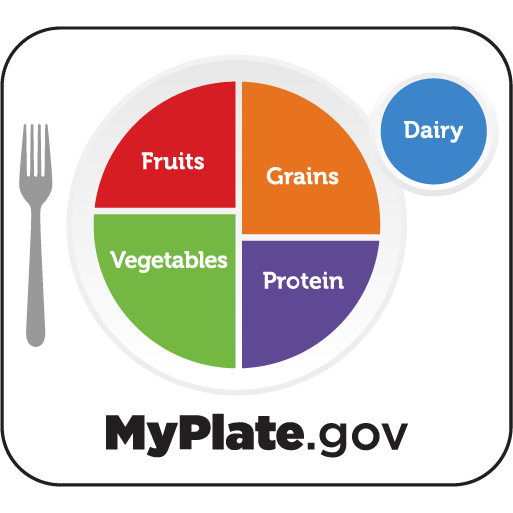
Food Prep for Hurricane Season
If you live in hurricane-prone areas like Puerto Rico, it is crucial to be prepared for hurricane season, which starts June 1st.
- By Angela from Piloto
- July 10, 2023
- Updated July 2, 2024
- 8 min read
Hey there, it’s Angela, your friendly neighborhood dietitian! Making sure you have enough food essentials is vital to ensure you and your family are well-prepared for emergencies or tough times. Whether it’s hurricane season, other natural disasters, or some unexpected events, having a well-stocked pantry can be a real lifesaver.
If you live in hurricane-prone areas like Puerto Rico, it is crucial to start preparing before the hurricane season begins on June 1st, extending until November 30th. Prolonged power outages, flood damage, and contaminated water after a hurricane are just a few reasons why stocking up on emergency supplies is essential.
Food Prep for an Emergency
Start Here 👇
1. Plan a menu that meets your family’s needs and preferences.
2. Write down a shopping list and calculate the daily portions you will need.
3. Aim for a supply that can last your family for at least 3-5 days, or even up to 2 weeks.
Tips for Food Prep & Storage
Tip 1: Choose foods that require little or no cooking and need minimal water for preparation
Tip 2: Choose foods available in individual or small packages to minimize leftovers.
Tip 3:Have foods that do not need refrigeration and are shelf-stable with a long shelf life.
Tip 4: Ensure you have enough storage space for food, water, and basic necessities. It should be a safe place protected from insects, rodents, pests, and potential flooding.
Tip 5: Include a variety of options that can be combined to create balanced meals and choose from all food groups.
- Protein: canned fish/chicken/beans and dried chickpeas/edamame, nuts, nut butter, etc.
- Grains/Starches: rice, pasta, crackers, oats, etc.
- Dairy: shelf-stable milk or dairy-free alternatives
- Fruits and vegetables: canned, dried, individual pouches, 100% juice
Comfort & Stress Foods
Having a small supply of comfort foods may help ease some stress and provide a sense of familiarity during emergencies. Plus, in the middle of a hurricane, you can’t go to your nearest drugstore to get your chocolate fix! Just make sure most of your emergency food supply is packed with nutritious options to maintain your health and energy levels.
Ideas for Your Healthy Emergency Food Kit
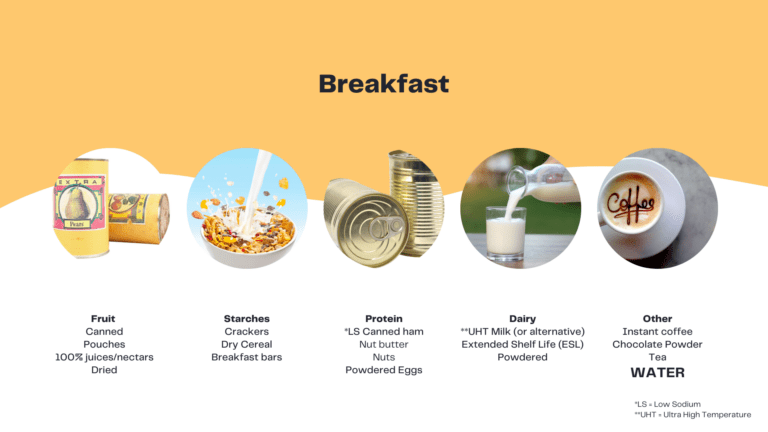
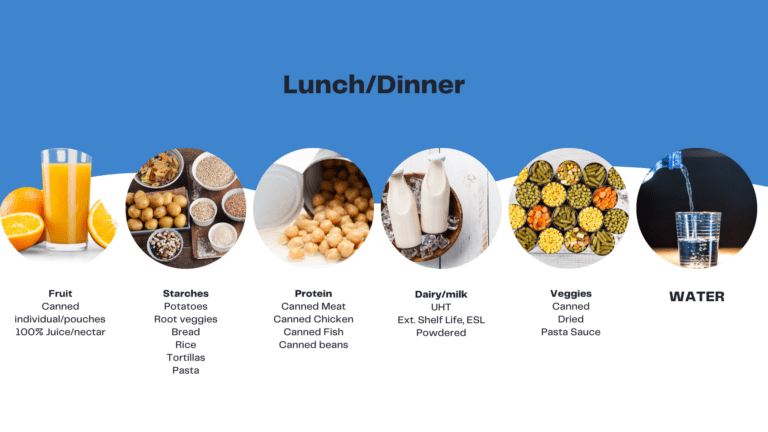
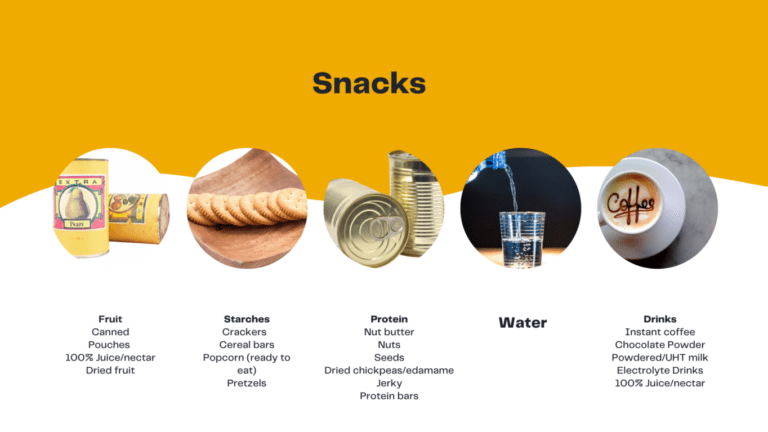
Menu Ideas

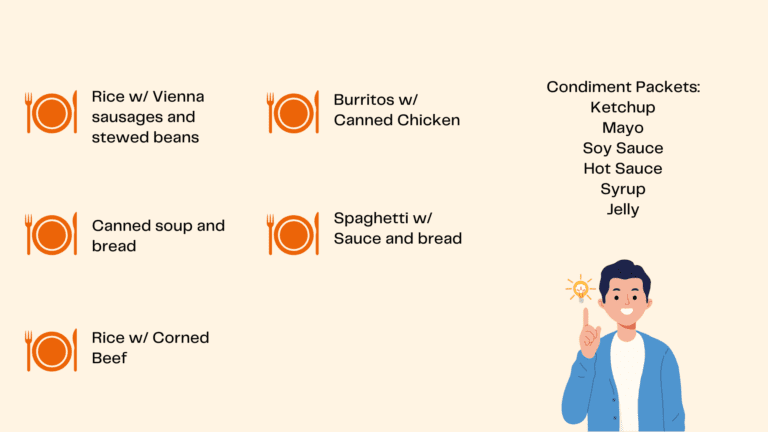
How Much Food & Water Should I Store?
💧 Water
- How much?
1 gallon per person per day (minimum!) for drinking and food preparation. You can fill clean containers with water, and if necessary, consider buying bottled water to supplement your supply. - Plus, store 1.5 to 2.5 gallons of water per person for bathing, brushing teeth, and dishwashing.
🥫 Food
Your food needs will depend on:
- Ages and number of family members in your household.
- Special dietary needs, including food allergies/intolerances.
- Food preferences.
- Your ability and available equipment to prepare food.
- Available storage space.
**Don’t forget to rotate your supplies! Keep an eye on the expiration dates of the food items and replace canned goods within 12 to 18 months. Periodically check the condition of your emergency food kit throughout the hurricane season.
Equipment for Preparing & Serving Meals
- Camping Stove or portable grill
- Fuel for cooking equipment (gas, charcoal, etc.)
- Matches or lighters
- Handheld can opener
- Pots and pans
- Utensils for cooking and serving
- Disposable plates, cutlery, and cups
Dos and Don'ts of Food Safety
Wondering what to do with food during or after a power outage?
Tip 1: Enjoy your fresh, perishable foods first. Then move on to items with a longer shelf life, such as canned goods.
Tip 2: If you are unsure if your food has gone bad….the general rule of thumb is “When in doubt, throw it out!”. Don’t risk food poisoning during an emergency!
Don’t!
- Do not eat food that has been in contact with contaminated water.
- Do not taste food to see if it’s “still good”. Ew!
Do!
- Throw out items that are moldy or have an unusual odor or appearance.
- Throw away refrigerated perishable food (meat, poultry, fish, eggs, dairy, and leftovers) after 4 hours without power.
Use opened canned goods within 4 hours (they can be contaminated once opened).
How to Keep Your Food Fresh During Power Outages
Fridge: Without electricity, your fridge will keep food cold for ~4 hours.
Freezer: Full freezer can maintain temperatures for up to 48 hours. A half-full freezer can maintain temperatures for ~24 hours.
How to Keep Your Food Fresh During Power Outages:
Use a Cooler: Move your perishable food items to a cooler and pack it with ice or frozen gel packs. Make sure there’s enough ice to maintain a temperature of 40°F or below. Add more ice to the cooler as needed to keep things chilly.
Plan Ahead: If you expect a prolonged power outage, consider getting dry ice or block ice. Fifty pounds of dry ice can keep an 18-cubic-foot freezer frozen for up to 2 days. (Be careful not to touch dry ice with bare hands or let it directly touch food.
About Piloto 151
Piloto 151 is the destination for virtual offices, flexible workspaces, and private office space. With coworking spaces in the heart of San Juan, Puerto Rico, our spaces have been designed to inspire creativity, cultivate connections, and celebrate wins.
Let us help you prepare your business for landing in paradise, from incorporating your business, getting a physical business address, and virtual mailbox services to permitting and certification under Puerto Rico’s world-class tax incentives, including Act 60. Contact us to get started.

